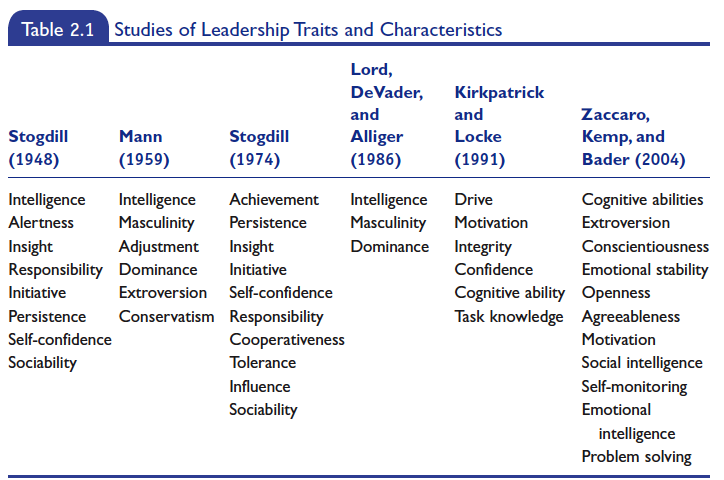
LER464:
Lesson 2: Trait Approach
Introduction
Lesson Overview
"Regardless of whether leaders are born or made or some combination of both, it is
unequivocally clear that leaders are not like other people. Leaders do not have to
be great men or women by being intellectual geniuses or omniscient prophets to
succeed, but they do need to have the "right stuff" and this stuff is not equally
present in all people." (Kirkpatrick & Locke, p. 59)
Reading Assignment
- Leadership: Theory and Practice, "Skills Approach," pp. 15-38
Lesson Objectives
When you have successfully completed this module you will be able to:
- appreciate how, throughout much of the 20th century, most researchers have regarded leadership as the personal qualities that result in a leader's gaining positions of authority and his or her subsequent success;
- understand the shift in focus over time from innate to acquired personal characteristics;
- become familiar with the traits that most consistently appear to distinguish successful leaders from ones who have limited success;
- learn how the trait approach accounts for the effectiveness of leaders; and
- recognize the value and limitations of assessing the effectiveness of leaders from this perspective.
----------------
Reference: Kirkpatrick, S. A., & Locke, E. A. (1991). Leadership: Do traits matter?" Academy of Management Executive, 5(2), 48-60.
Traits
Historically, research about the trait perspective focused on genetic influences as determinants of leadership emergence and effectiveness. This yielded little consistent evidence of what contributes to the two elements.
For example, in the 19th and early 20th centuries, the popular "great man" theory embodied the view that leaders are predominantly male and born, not made. However, supporters of this view did not have much to say about which specific genetic qualities beyond maleness were responsible for one's reaching a position of leadership.
Identification of the critical inherent attributes was something that preoccupied scholars interested in leadership for much of the first half the 20th century. In the second half, they began to shift attention to "acquired" traits. But trait theorists have not satisfactorily addressed how personal qualities, either genetic in origin or cultivated through experience and socialization processes, account for movement into positions of leadership and how leadership success is attained.
Trait Approach
As noted, more recent interest in the "Trait Approach" has focused on acquired qualities; the exclusively genetic perspective is largely dead.
See the reproduction of Table 2.1 from your textbook below and note that almost all of the traits that scholars have identified as sometimes distinguishing leaders from non-leaders are acquired, not qualities with which one is born. Ignore the citation of French and Raven in Table 2.1 on p. 19 of the reading assignment, because it is incorrect.

Table 2.1
Note. From Leadership: Theory and Practice (p. 19), by P. Northhouse, 2010, Washington D.C.: Sage Publications, Inc. © 2010 Sage Publications, Inc.
Reproduced with permission of SAGE PUBLICATIONS INC BOOKS in the format electronic usage via Copyright Clearance Center.
Variables for Leadership
The following are the five most consistently discriminating variables for leadership emergence and effectiveness, along with their most salient features:
- Intelligence: Having good reasoning and thinking capabilities, as well as developed verbal ability, and using sound judgment in solving problems and making decisions
- Self-confidence: A strong sense of one's ability to produce desired outcomes that can influence risk-taking and the acquisition of others' trust
- Determination: Drive, initiative, and a willingness to be assertive and show dominance, if necessary in situations arises in which others may need direction.
- Integrity: Trustworthiness, the capacity for inspiring confidence in others, honesty, dependability, and loyalty to others on whom one depends for this or her success
- Sociability: A quality characterized by courtesy, tact, diplomacy, friendliness, and the inclination maintain pleasant social relationships
----------------
Reference: Kirkpatrick, S. A., & Locke, E. A. (1991). Leadership: Do traits matter?" Academy of Management Executive, 5(2), 48-60.
Personality Characteristics
Ernest Tupes and Raymond Cristal originally formulated a model of personality characteristics which included: neuroticism, extraversion, openness, agreeableness, and conscientiousness. These, along with emotional intelligence (the ability to understand emotions and to use such knowledge to perform tasks—see work by Daniel Goleman), also seem to have some bearing on who moves into positions of leadership and how effectively leaders function.
Five Personality Factors
| Five Factors | Personality Description |
|---|---|
|
Neuroticism | A generalized tendency to experience unpleasant emotions, such as depression and undue anxiety |
| Extraversion | Outgoingness and the tendency to seek stimulation in social environments |
| Openness | Receptivity to novelty in modes of thought, feeling, and behavior, as well as tolerance for diversity |
| Agreeableness | A propensity for being compassionate, cooperative, and supportive of others |
| Conscientiousness | High in self-discipline, commitment to task completion, sense of organization, and dependability |
Try taking the Personality Patterns test from at Signal Patterns to see your traits.
Strengths of the Trait Perspective
The strengths of the trait perspective are its:

- consistency with popular conceptions of leaders and leadership;
- strong research foundation;
- focus on occupants of leadership positions; and
- benchmarking value for judging who may and may not be good leaders.
Weaknesses of Trait Perspective
The weaknesses include its:
- absence of a definitive list of distinguishing characteristics;
- relative inattention to situational factors;
- encouragement of subjective interpretations of what is important to successful leadership;
- limited understanding it provides of the relationship of traits to performance outcomes and the implication that what contributes to emergence also accounts for effectiveness; and
- restricted value in training leaders.
Thought Questions
- The so-called “Great Man Theory” of leadership (see Northouse, pp. 15-16) entails the notion that leaders are born, not made. If we have little evidence for this theory, why do you suppose that it persists?
- In its new form, the trait perspective focuses on acquired, as opposed to inherited, characteristics. (The possible exception is intelligence, and many people even view this as acquired rather than inherited.) Northouse (pp. 19-22) identifies five general categories of such traits: (1) intelligence; (2) self-confidence; (3) determination; (4) integrity; and (5) sociability. Rank these five in respect to how you see their relative importance in contributing to how a person emerges as a leader. Then do the same for how you see their relative importance in exercising leadership. In short, you are being asked to judge whether or not what contributes to someone becoming a leader is the same as what determines how effective the person will be once in a position of leadership.
- In addition to the five traits above, Northouse suggests that personality factors (neuroticism, extraversion, openness, agreeableness, and conscientiousness), as well as emotional intelligence (the ability to understand emotions and apply the understanding to tasks), also relate to one’s prospects for moving into positions of leadership and his or her effectiveness once there. Do you see these factors as more or less critical than the other five? Which and why?
- Northouse (pp. 25-27) discusses both strengths and criticisms of the trait perspective. After reading his digest, do the strengths, in your judgment, outweigh the criticisms in viewing leadership from this perspective? Why or why not?
- Read the three case studies Northouse (pp. 28-32) presents, and think about how you would answer the questions posed at the end of each case study. Why do you feel as you do?
- Think of someone you know in a position of leadership in a group or organization, whom you consider to be an effective leader. Then rate that individual on the fourteen items Northouse presents on pp. 33-35. Which of the fourteen seemed to have the greatest and, conversely, least weight in shaping your overall impression? In retrospect, were you surprised by how much or little any of the items had to do with your perception of the leader’s effectiveness? From having completed this exercise, do you feel that perceptions of leadership may be unduly (that is, overly or insufficiently) affected by some traits? How did you arrive at your view?
Activities
Leadership Traits Essay
For Lesson 02, write an essay of approximately 1,000 words in which you perform all the tasks identified and respond to all of the probes for Thought Question 6. Make sure that you identify the person on whom you will be focusing. If you prefer not to use the person’s actual name, a pseudonym will be acceptable, but please indicate that you have made such a choice. For instance, “In this document, I refer to the person I have chosen for the assignment as ‘Mary Smith.’ Mary is the CEO of a small company that specializes in...I was a member of the firm for a period of time.” In preparing your essay, refer directly to the material in the reading on which you draw. For example, “I was not surprised by how few of the items in questionnaire appear to account for Mary’s success because, among other things, as Peter Northouse points out, ‘. . .' (p. 36).”
Expected Outcome
In this lesson, you completed the reading assignment, worked through the thought questions, and wrote an essay on Thought Question 6. Now, you should have a clearer grasp of how the trait perspective can help to account for success in leadership, as well how it is deficient.
Contribution to Course Grade: 8%